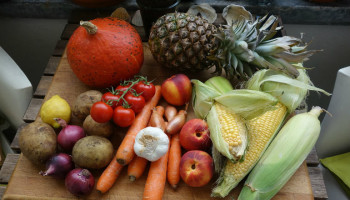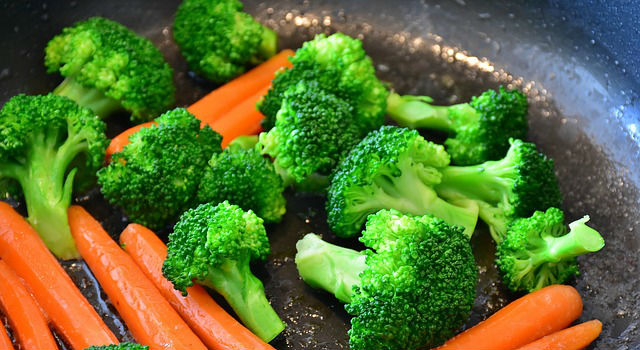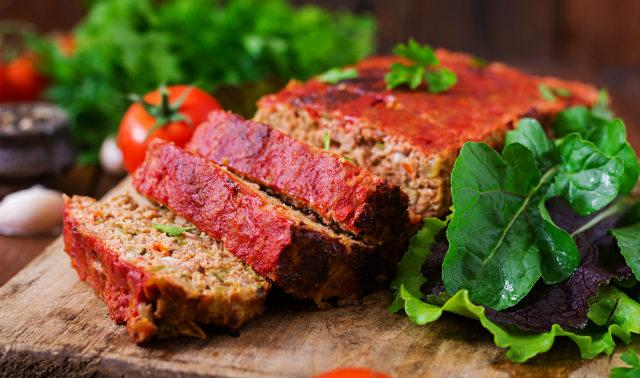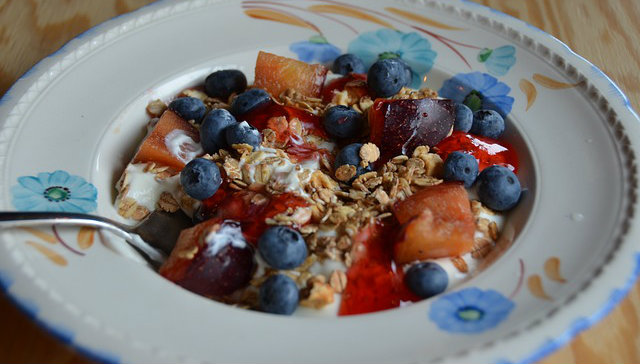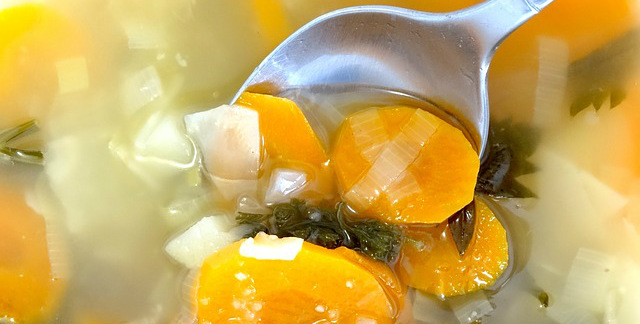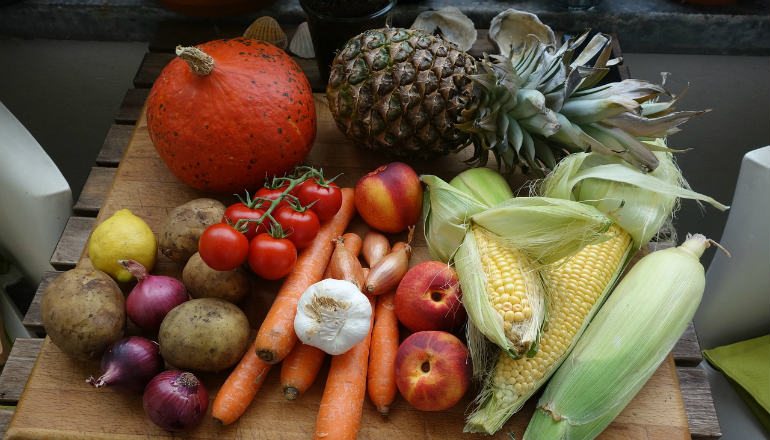 Reading Time: 9 minutes
Reading Time: 9 minutesI make a living telling people to eat more veggies. This is according to my wife. I do a few more things, but I understand her point. Whenever I am on the phone with a client, we are almost always discussing how to get more fruit and vegetables into his or her life.
There are a number of reasons to eat vegetables, none of them being to torture you. Your fiber will be consistent, your nutrient intake will be higher, and you’ll feel great. In other words, digestion will be smooth sailing and your vitamin and mineral intake will be boosted.
The Internet is full of opinions, quick fixes, elixirs, trends, and programs, but almost none of them debate the fact that eating vegetables is a wise thing. It’s one of the few widely accepted nutrition facts.
Besides daily health and digestion, high fruit and vegetable intake is linked to lower incidences of many diseases. Certain cancers, diabetes, high blood pressure, and other metabolic ailments are just a few examples. If you are looking to lose weight, vegetables fill you up and are low calorie.
Whoever you are and whatever your goals, I can make a case for you to up your vegetable game. So, here’s how you do it.
Your Goal: 2 Servings of Vegetables per Meal
My big recommendation is that you eat two servings of vegetables or fruit at each meal. While I recommend getting more veggies than fruit, it depends on the season and you really can’t go wrong with either. Both are healthy and full of nutrients.
A “serving” equals about 1 cup. So, aim for 2 cups per meal. You can do 1 cup of vegetables with your main dish and 1 cup of fruit for dessert, if you like. When you are home, try to measure out your servings for a few weeks so you can train your eye on what a “serving” really looks like.
If you take this advice, you’ll quickly notice that eating two servings of vegetables per meal will be difficult at first. They take some time to plan for and prepare. There are days where I look back and say, “Wow, I had zero vegetables today.” It takes some effort, but you’ll get used to it and feel great.
When beginning to add in more veggies, there are a few concepts than can help make it easier for you:
- Go with cooked vegetables as often as you can at first. They will be easier to digest.
- Pick vegetables you know you like. As you get more into the habit, you can get more creative.
- At certain meals, breakfast being a common one, you can add in fruit instead.
- Don’t be afraid of canned vegetables. They may not be perfect, but they are quite convenient.
- Add a side salad to your meal if you get stuck.
- Frozen veggies are great. They are frozen when ripe. Fresh, seasonal vegetables are best, but frozen is a close second.
As you get better at preparing and eating fruits and vegetables, start to think about eating different types at each meal. Instead of two servings of green beans, have one serving of green beans and one of beets. The more colorful the plate, the wider the variety in terms of different nutrients.
Make this vegetable-eating thing doable for you. You don’t need to start by eating two servings at every meal. Assess where you currently are, and make a transition plan you can be confident about. It can take weeks or months. Many times, I have someone start out by eating one vegetable a week, and then building on that momentum. These small steps lead to big time changes before you know it.
There you have it: my big summary on vegetable habits. Now, let’s dive into some things you can start doing this week that will get you started eating more delicious plants. Here are six of the most impactful and easiest ways to get going.
1. Sneak Vegetables into Your Meatloaf
Do you have a favorite recipe for meatloaf? I’ve found you can take pretty much any standard method of making a meatloaf and replace about 25% of the meat with vegetables. Alternatively, you can also keep the same amount of meat and add 50% vegetables. For example, if the recipe calls for 3 cups of meat, you can add 1.5 cups of vegetables to the recipe and end up with a larger meatloaf.
Onions, carrots, celery, spinach, Brussels sprouts (cooked beforehand), and radishes all go well in meatloaf. I recommend that you first put them in a food processor and mince them quite fine. Then, mix your veggies right into the chopped meat, and follow the recipe as usual.
I don’t have a specific meatloaf recipe to give you. Whenever I am in the mood, I just find a new recipe on the Internet and add my vegetables mixture. In addition to adding nutrition, I think it also enhances the flavor and texture, as it helps avoid drying out the meat. Almost any recipe will work, so pick one that looks good to you and give it a shot.
2. Add Frozen Spinach to a Shake
If you use a shake as a meal replacement, you can add a small amount of frozen spinach without sacrificing flavor or texture. If you are using a blender, try adding in about a handful of frozen spinach.
Be forewarned that it may not wind up being the best colored shake, especially if you also use blueberries. It will look like something out of a scary movie, but will taste just fine.
3. Make a Vegetable Omelet
A great way to get more veggies is to put them in an omelet at breakfast. I usually use sautéed spinach, broccoli, and onion. You can, of course, use any vegetable you like.
There is no rule saying an omelet has to be a perfect half circle, by the way. I simply sauté onions in a little olive oil, and once they become clear, I add in the broccoli, spinach, and scramble eggs directly into the pan. About a cup of total vegetables is perfect.
Instant or steel cut oatmeal with berries and bananas on top is great side for your omelet. Greek yogurt with the same fruit works well, too. Either way, the result is a high protein, high fruit and vegetable meal. As great as this is to make at home, it’s also a good meal to remember when you’re dining out or on vacation. Almost every diner will have the omelet option, and you can typically substitute the standard toast or waffles with your oatmeal and fruit.
4. Make a Stir Fry
As a kid, I always loved baby corn in vegetable dishes. For some reason, I thought it was a rare treat. Then, I got older and realized I could purchase them in a can for a few bucks. So, don’t forget about these as well as water chestnuts. Both are great in a stir fry as they add flavor and texture.
When in doubt about which veggies to make, use a can of baby corn, can of chestnuts, finely chopped broccoli, squash or zucchini, and green onion. Simply sauté them in olive oil or a small amount of your favorite Asian sauce (or both). There is no rule here as to how long to cook it for. It comes down to how crunchy you like your vegetables.
Instead of a sauce, a combination of spices can also work well. I like to use cayenne pepper, sea salt, basil, and cumin. There is no wrong answer when it comes to spices.
5. Purchase Fermented Vegetables (or Make Your Own)
Fermented. Does that word turn you off? It does for many people, until I explain that a lot of common things are made by fermentation. Yogurt, beer, sourdough bread, sauerkraut, kimchi, and cheese are all examples.
Fermentation is simply a manipulation of the environment so that bacteria makes our food delicious. (That may not be the official definition.) I can write an entire essay on fermentation and its benefits to us, but for our purposes here it’s just another tasty and healthy way to eat more veggies in forms like sauerkraut and kimchi. Eating fermented foods also helps our digestion quite a bit, which can be great when you’re getting started with a higher plant food intake.
You can usually find sauerkraut and kimchi at the grocery store. I use sauerkraut whenever I make sausage or kielbasa. Kimchi is a spicy cabbage that makes anything bland taste better (like leftover chicken).
To get the most benefit, the sauerkraut or kimchi you purchase must be found in the refrigerated section. This refrigeration slows down the fermentation of the live cultures so the package won’t explode from pressure or turn too acidic. If you find the product in the regular aisles that means the bacteria culture is dead and the food will not have as much benefit to you.
A fun way to get fermented foods is to make your own. I recently made fermented carrots that came out delicious. Here’s how:
- Chop raw carrots into small pieces (no rule here)
- Add 2 to 4 teaspoons of sea salt, and mix together trying to squeeze any juice out of the carrot. It also helps bruise the carrots and accelerate the bacteria fermentation.
- Put in a jar, press the carrots down and try to compress them.
- Cover with filtered water, and put a lid on the jar.
- Within a few days, it’ll start to bubble. It will bubble to the point you need to open the lid and let the air out before the jar bursts.
- Try the carrots every few days until you are satisfied with the taste. At this point, put the jar in the refrigerator.
6. Make a Slow-Cooker Soup
That three-pound bag of carrots at the grocery store always seems like a good idea, until you realize that’s way too many carrots and they will go bad. Whenever you have extra veggies in your drawer that you’re not sure what to do with — make a soup.
Simply purchase vegetable or chicken broth, put the vegetables in a slow cooker, and cover them with broth. Salt, pepper, thyme, and rosemary make nice spice additions. Then set the slow cooker on low for 8 hours. After eight hours, you’ll have easy soup you can eat with any meal.
More Veggies = More Fun
Mom was right — eat your vegetables. But they do not have to be mundane.
Think of vegetables as a palate that you can flavor however you like. No need to overthink which ones are better or what type of preparation is best. Any uptick in vegetable or fruit intake will make you healthier. Just don’t be afraid to try new things and vary your diet. Your body will thank you regardless of your goals.
